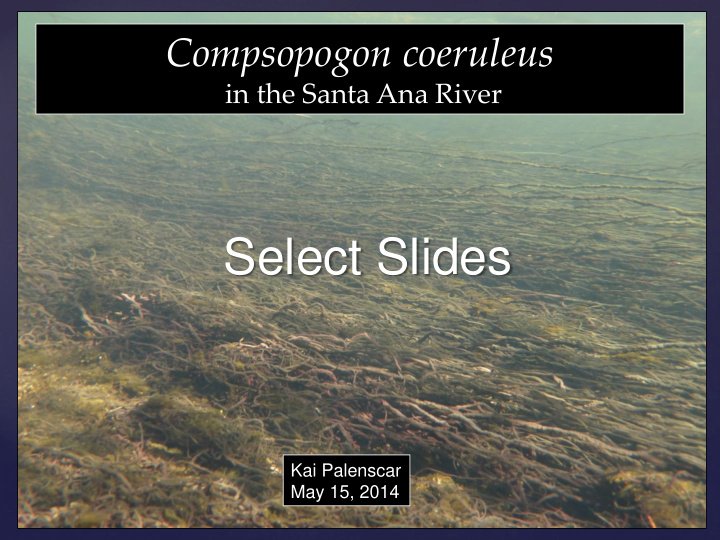



Compsopogon coeruleus in the Santa Ana River Select Slides Kai Palenscar May 15, 2014
17 Non-native fish removed: February 13, 2014 2 largemouth bass 14 black bullhead catfish 1 green sunfish Algae first noted as potentially problematic during non-native fish removal at the RIX discharge pool. In attendance USFWS, USFS, CDFW, RCRCD, SBVMWD, RIX personnel
Algae collected from RIX discharge pool Feb. 13, 2014 – dark brown/black and filamentous Downstream of discharge pool Feb. 25, 2014
Preferred Habitat (Necchi et al 2013) Aquarium RIX* Discharge Rialto Channel Epiphytic Pest • Wildland Clear Water • Rapid Velocity • Hard Substrate • Water Temp. • Mean 70°F (20°C) • Min. 56°F (12°C) • pH • Algae Present usually alkaline >7.5 Algae Not Present • Specific • Conductivity Algae Habitat = Sucker Habitat Wide Range: • fresh to brackish water *RIX – Rapid Infiltration and Extraction
Preliminary survey of algae distribution conducted by Riverside-Corona Resource Conservation District Rialto Channel Algae coverage lower in sandy areas. RIX Outfall Pool Riverside Ave. Mission Ave. 80-100 % ___ 50-80% ___ <10% ___
Pre-invasion – fall 2011 Post-invasion – Feb. 25, 2014
Santa Ana River Population of Santa Ana Sucker
Potential Range of the Santa La Cadena Bridge Ana Sucker in the Santa Ana River (32 river miles) Colton Chino Hills Riverside Prado Dam Weir Canyon Drop Current distribution much more Structure limited.
Survey for Santa Ana Sucker February 25, 2014 • Snorkel Survey • Riverside Ave. to RIX discharge pool • Data • Underwater video/photos • Location of sucker and algae presence • Results • Algae cover is 75-100 percent of river bottom • 135 Santa Ana sucker observed (80-150 mm) • Arroyo chub more common (adults and juveniles)
Survey Points for Snorkel Survey (Feb. 25, 2014): Red = sucker occurrences Blue = Riverwalk data point locations
Threats to the sucker in the Santa Ana River Long-term viability is precarious due to the limited extent of suitable habitat • Habitat is limited by • barriers, water availability and rocky substrate (cobble/gravel) • Other threats • non-native aquatic species, off-road vehicles, water quality, hydrologic regime, water temperature (?), algae (?) • Amount of suitable habitat • At time of listing - 32 mi. (defined by river barriers) • Actual - <7 mi. (defined by presence of rocky substrate) • Without algae - <½ mi. (majority = Rialto Channel) • Algae is a new potential threat to Santa Ana sucker and its habitat that we need to further evaluate.
Current Santa Ana River after rain event at Rialto Confluence March 1, 2014 Conditions • Since February, three precipitation events have occurred • Algae density decreased with each rain event • Regrowth estimated at 1-2 cm per day At RIX Discharge Location Between RIX and Riverside Ave. May 2, 2014
Next Steps - What do we do now? • Determine nativity and range in CA • Few occurrence records (northern and southern CA, all recent) • Determine threat to the sucker • Survey river for presence and measure regrowth • Conduct trials at RCRCD – feeding/spawning • Management • Containment to Santa Ana River • Control • Chemically (copper sulfate, chlorine, barley extract?) • Drying - Realign upper portion of the river and allow to dry • Partners • USFWS, USDA, USACE, CDFW, RWQCB, MWD, local cities, flood control, local water agencies (SBVMWD, SBVWCD, OCWD, SBMWD, etc.), CSU San Marcos – Sheath Lab.
Recommend
More recommend